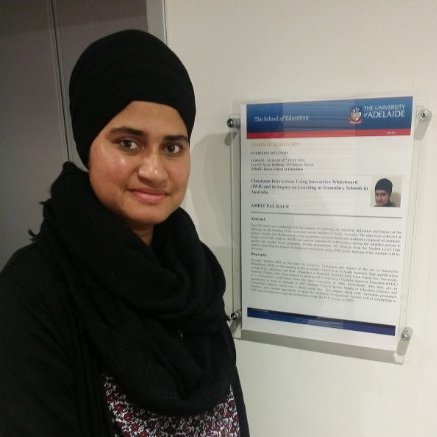Teaching with technology
Classroom teaching is a very challenging job because it is not just about giving instructions but includes many other tasks which teachers need to perform on day to day basis. For instance, apart from preparing and delivering the lessons, a teacher has to assess the learning, provide feedback, keep track and report the progress of the students, manage student behaviour, organise the classroom and most importantly inspire the students to learn and thrive to reach their full potential. Among these, the most difficult is to inspire the students to learn, which we know, is the ultimate end-product of the education process.
Today teachers are dealing with the students whose lives are immersed in technology and they spent most of their time interacting with latest technological gadgets. In order to engage these digital natives in their learning, it is crucial for teachers to integrate latest educational technological tools into their teaching. These tools can, not only support learning, but also be very useful for the teachers to manage other important classroom tasks, which play equally important role in creating an effective learning environment.
...LFTs and other modern day educational technologies come to rescue which help the teachers to teach and manage classrooms in an easy but effective way.
One such popular technological tool is called Large Format Touchscreen (LFT), also known as Interactive Whiteboard (IWB) or electronic whiteboard. LFTs have already been widely adopted at the primary school level across Australia and now entering the secondary and tertiary level classrooms as well. In this blog, my aim is to highlight the research findings about the benefits of this technology for teaching, including the findings from a study I conducted to investigate the use of LFT technology at 12 South Australian secondary schools which included 30 teachers and 269 students.
Research has clearly shown that teachers adopt LFT technology mostly because of its usefulness in teaching in easy, interesting and better way. To elaborate this point, I have enlisted the research findings highlighting the advantages of these large format touch screens:
- The teachers can easily cater for a variety of learning styles using LFTs because they provide the option to deliver multimodal presentations very effectively.
- The ability to write/annotate on the screen; record and print the lessons; instantaneous access to internet and various interactive resources help teachers to teach in an easy and interesting way.
- This technology also helps teachers to develop the structure for their lesson plans and incorporate resources in their lessons more easily. There is also an option to use a pre-prepared lesson which teachers can also review at a later date.
- Another unique feature of LFT is that it encourages interactivity in a classroom setting i.e. dialogic interaction among students, and between students and teachers (pedagogical interactivity) and also the physical interaction with the LFT itself (physical interactivity). Both these kinds of interactions motivate the students to participate in discussions and problem solving and are considered very important for effective teaching for constructive and collaborative learning.
- Using LFTs help teachers to maintain an eye contact with the whole class while standing in front of the class because the teachers does not have to sit or stand on one corner of the class hiding behind the computer screen. Further, if a tablet is connected with LFT, teacher can also go around in the class while his/her work being displayed on the large front screen. This helps in maintaining the pace of the lesson along with teacher being able to manage the class more effectively.
- It has also been found that the use of LFT technology leads to improvement in learning approach of the students as they become more motivated, interested and engaged in learning. More specifically, it has been noted that lower ability students or students with some disability develop positive approach towards learning when taught using these interactive touch screens.There is also some evidence of link between the use of LFTs and better learning outcomes in the form of improved understanding of difficult concepts, abstract learning and the construction of new knowledge by the students.
It is not uncommon for teachers to feel overburdened, frustrated and even exhausted due to various demands of classroom teaching especially the pressure to support student learning. This is where LFTs and other modern day educational technologies come to rescue which help the teachers to teach and manage classrooms in an easy but effective way. If integrated properly, these technological tools have the potential to revolutionise teaching by establishing learning environment that supports and facilitates students as they construct their own knowledge.

Dr Amrit Pal Kaur PhD
University of Adelaide

Dr Amrit Kaur is a recent PhD graduate in Education from the University of Adelaide. For her PhD in the School of Education, Dr Kaur investigated the adoption and impact of interactive whiteboard use on student learning. Her study involved 12 South Australian public and independent secondary schools, with 269 students and 30 teachers participating in the research.
Dr Kaur additionally has a Master of Science (Hons.) and Bachelor of Education from Guru Nanak Dev University in India, as well as her Master of Education (Science & Technology) from the University of Adelaide. She is a guest lecturer at the same institution and is in the process of working on further research pieces for publication.
News & Events
Keep up to date
-
28 Oct
Ricoh Australia Named a Finalist in the ARN Innovation Awards for Sustainability
-
17 Oct
Ricoh recognised among Forbes’ World’s Best Employers 2025
-
19 Sep
Ricoh named in TIME World's Best Companies of 2025 for employee engagement, growth and sustainability
-
27 Aug
CMYK Colour Online Renews Contract with Strategic Print Partner Ricoh
